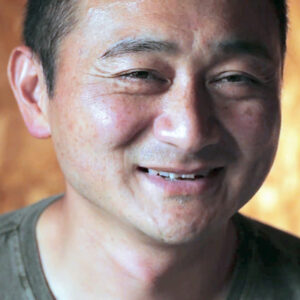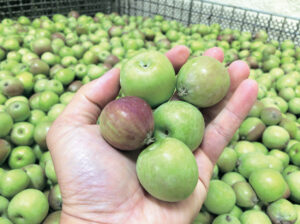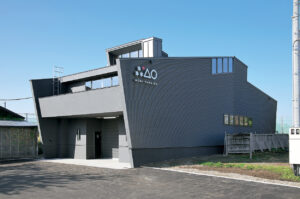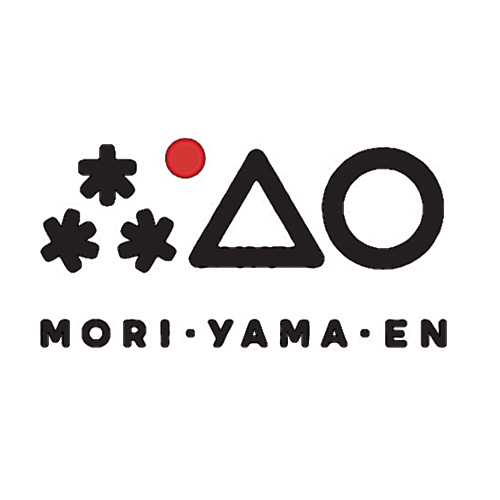For a company that’s only been producing cider for a little over a year, Moriyamaen, located in Hirosaki in Aomori Prefecture, is on the fast track to possibly becoming one of Japan’s most recognizable cider brands wit their “Tekikaka Cidre”. Their success so far is thanks in no small part to the leadership of Toshihiko Moriyama, the company’s forward-thinking, charasmatic president, who took time out of his busy schedule to answer a few questions.
Can you tell us a about yourself and your background? How did you get into apples and cider?
I was born in 1972, the fifth generation of Moriyama apple farmers, which happens to be the apple farm with the longest history (over 100 years) in Japan. I started working for my father immediately after graduating from college, and took over the farm in 2015 when we incorporated. Realizing that growing
apples is in Japan not only requires a lot of work but is also inefficient, and after having experienced the damage caused by typhoons, hail, and other natural disasters, I felt I had to help make our farm sustainable and a growing company or else people would leave and devastate our region’s economy.
I came up with three ideas: develop a cloud-based application to visualize the overall farming process and identify labour productivity; use the fruit collected from immature trees that would ordinarily be thrown out for cider making; and launch a company to cultivate mushrooms from the branches we tirelessly prune each year.
It’s taken three years to make it work, but now we’ve gone from a farm that used to only provide apples to the JA (Japan Agricultural Cooperatives) to investing over a million dollars for our own cider and mushroom cultivation facilities.
What were some of the early challenges you faced? Moriyamaen the company started in 2015, but Tekikaka Cidre wasn’t released until 2018. How did that come about?
After experiencing the damages caused by hails storms in 2008, I became interested in cultivating apples for the sole purpose of making processed apple products, but there isn’t much profit in that. So, about five years ago, I thought about using the apples that we throw out during the thinning process – a process called “Tekika” – to make cider. I figured by using the astringency and sourness of these immature apples, we might have a chance to compete with other ciders even though we are years behind other coutries in cultivating cider variety apples.
Our next challenge was the problem of pesticide use, which took us five years to solve. Now we employ a safe cultivation method that uses half the pesticide and at nearly half the cost.
During this time, I joined the newly established “Hirosaki Cidre Study Group” was established and met Fujiko Aoyama, a part-time high school teacher and cider yeast researcher, who told me her dream was to make a cider from a yeast she had developed herself. After undergoing “Alcohol Brewing Technology Training” at the Hirosaki Institute of Industrial Science and Technology, she volunteered to research and experiment making Tekikaka Cidre, with the goal of creating a drink as refreshing as beer.
The journey took three years after experimenting with over 20 yeast strains. When the factory was completed last October, we formally hired Ms. Aoyama, who then acquired a brewing license. We started manufacturing in December and the first bottles were released for sale in February of this year.
Can you tell us about Tekikaka Cidre itself, what’s the process that goes into making it? What apples are used, etc.?
This year we collected 27 tonnes of apples through tekika, this yielded 30 kiloliters of cider. From that we were able to manufacture about 2300 liters of cider each month, independent of season.
We use a blend of about 20 varietals, but Fuji apples make up about 50% of the base. To help balance the sourness of the immature apples, we mix about 30% juice from ripe apples and no other sugar is added.
How have sales and initial reception been, and what were some of the earlier challenges you faced?
In the beginning things were tough. Our name was unknown and we didn’t have any sales channels, so it was nonstop meetings for the first two months after our release in February. After not doing as well as we’d hoped by producing a lot and going through a local wholesaler, we decided to switch gears and negotiate directly with restaurants, bars, and liquor shops. This has helped, is helping, but we still haven’t reached a breakeven point. We also had problems with large scale bottle conditioning, which resulted in a high number of overly carbonated bottles; we’re still searching for a midway point between what our ideal level of carbonation is versus what our customers want, as well as working on establishing a process to reach consistently stable levels of carbonation.
Although you’re based in Hirosaki in Aomori Prefecture, you’ve been extremely active about promoting and selling Tekikaka elsewhere. I first met you at FoodEx in Tokyo, and have seen you at events in Nagano Prefecture. How important is that to the success of your brand?
If we had ten years, we might have been able to establish our brand first in Aomori, but since we are the odd ones out, we believe we need to be agressive to survive. We’d like to follow the example of Dassai Sake, who became popular in Japan by first gaining recognition overseas.




What’s the cider scene like in Hirosaki? For some, considered the birthplace of cider in Japan. Any similarities and differences with other areas?
Despite the claim, Hirosaki sadly still hasn’t gotten that far and cider itself is not at all a well-known drink. Like everywhere else, the cider you do see here tends to be the bigger, more commercial ciders. In general, in Japan, the public view of cider seems to be as a drink that’s too sweet to enjoy with food. This is why I believe restaurants and bars should serve a wider variety of distinctive brands to help improve its overall image. I’m envious of Nagano, with folks like St. Cousair leading the industry, who are working hard to establish a connection between cider-related tourism and local businesses.
The current cider boom in North America reminds me of when Starbucks was first getting popular in the late 90s. Did you know it took 17 years for the first Starbucks to open in Hirosaki? It would be great if Moriyamaen could ignite our own local cider boom, but in order to do that, we would need the same kind of money required for rocket development and as much energy as nuclear fusion!
How is Tekikaka being received now? You recently received two stars at this year’s Japan Cider Awards and also a silver award at the Japan Cider and Perry Awards. How does that make you feel?
Very pleased, of course. The comments we see online by people who have tried our cider is very encouraging.
What are your plans and goals for the company in the near future?
We’ve just starting kegging Tekikaka Cidre for restaurants and bars with the intent to produce more than the breakeven point by next spring. Furthermore, we aim to create a system so that apple farmers in Aomori Prefecture can create revenue from their own tekika apples.
Right now we operate with only eight employees, and I am blessed to have a truly wonderful team. I wish to continue moving forward with them, I want our company to be known to the world as a company that continually strives to create new value, and one that uses all of our resources without waste.
NOTE: After the writing of this article, Toshihiko Moriyama received the “Highest Excellence Innovation Award” from the Aomori Innovation Network Group for the three ideas mentioned in his answer to our first question: developing “Ad@m” – a cloud system to record and manage apple production, devising productive ways to use fruits that would have otherwise been disposed of, and conceiving the use of cut branches as fungal beds. Congratulations and well-deserved!
MORIYAMAEN
HOURS OF OPERATION:
Mondays through Fridays: 9:00〜17:00
Saturdays & Sundays: Closed
ADDRESS:
〒036-8253 Aomori, Hirosaki, Midorigaoka 1-10-4
TEL: 0172-78-3395
https://moriyamaen.jp

